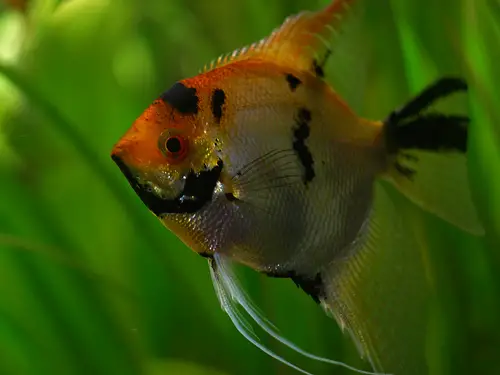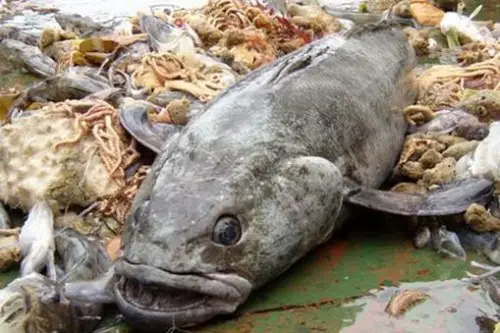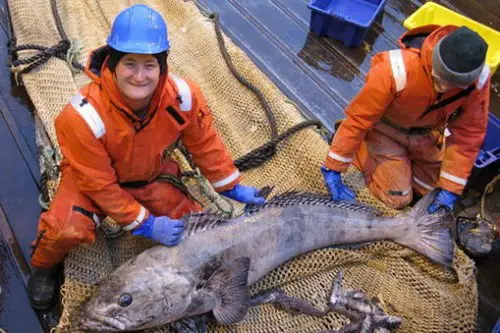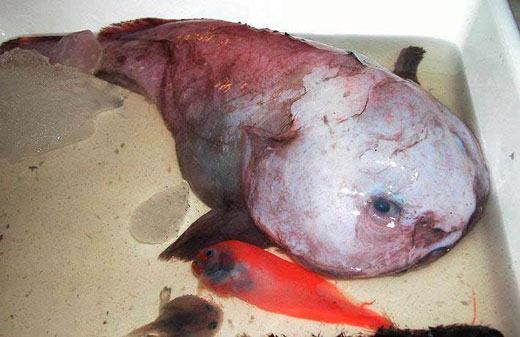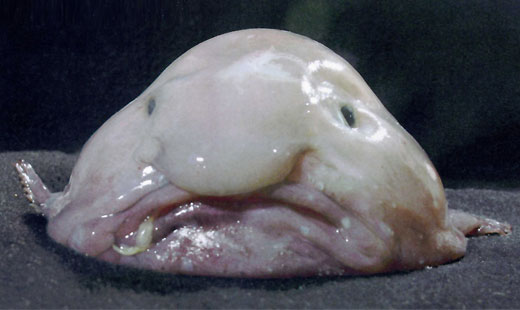Pterophyllum is a genus of freshwater fish from the Cichlidae
family more commonly known as angelfish. All angelfish species actually
originate from the Amazon River, Essequibo River, and Orinoco River
basins in South America. There are 3 Pterophyllum species which are
known for being laterally compressed round bodies and elongated
triangular anal and dorsal fins. They are naturally striped which
provides this fish with camouflage.
Angelfish are ambush predators that prey on macroinvertebrates and small fish. All angelfish species form monogamous pairs. They lay eggs on a flattened leaf or a submerged log and care for their brood.
Pterophyllum scalare was the first freshwater angelfish that was talked about in 1824. It was described by Lichtenstein. In 1906, Pellegrin discovered the Pterophyllum altum. In 1963, another species of Pterophyllum was discovered, called P. leopoldi. This was described by Gosse as an angelfish as they were first described under a different name.
Pterophyllum altum are also known as altum angelfish, deep angelfish, or Orinoco angelfish. They still can be found in the wild strictly in the Orinoco River Basin and the Upper Rio Negro watershed in Venezuela, Colombia, and Brazil. This species is the largest of the Pterophyllum genus, and specimens exceed over 50 cm in height in the wild. However, aquarium specimens are known to grow up to 40 cm. Its is silver coloured, with 3 brown or red vertical stripes. It also has red striations on the fins. It may have red spots and a bluish green overcast when it matures. When it is aroused, it shows a black operculum spot. This fish is the national fish of Venezula and appears on some Venezuelan currency notes.
The Pterophyllum leopoldi is also known as the dwarf angelfish, long-nosed angelfish, teardrop angelfish, or the Roman-nosed angelfish. It originates from the Amazon River basin. Unlike other Pterophyllums, it does not have a pre-dorsal notch. It is the smallest of the angelfish species and is also the most aggressive one.
Pterophyllum scalare is the most common angelfish, and is commonly referred to just as “angelfish” or “freshwater angelfish”. It is the most common species in captivity, but its natural habitat is in the Amazon River basin, the rivers of Amapa in Brazil, the Oyapock River in French Guiana, and the Essequibo River in Guyana. It is found in swamps or flooded ground where vegetation is dense.
In the late 1920s and early 1930s, angelfish were bred in captivity in the USA. They are currently one of the most commonly kept freshwater aquarium fish which are prized for their unique shape, colour, and behaviour. It is an intelligent fish as they are able to recognise their owners. The most commonly kept Pterophyllum species that is kept in household aquariums is the P. scalare. P. leopoldi is the hardest to find.
Angelfish should be kept in a warm aquarium that has a temperature of about 27 °C. They should be fed a mixture of live, frozen, and flake foods. Owners should make sure not to overfeed them, as angelfish will continue to eat even if they don’t need to. If they are overfed, fats will build up resulting in inactivity and they will die an early death. Angelfish will keep well in an acidic environment, with a pH level of 7.0.
Although angelfish are generally peaceful, the general rule is that big fish will eat little fish. Aggressive fish should not be kept with the angelfish because their flowing fins are vulnerable to fin nipping. Even some small but aggressive fish will nip at the angelfish’s fins. Freshwater angelfish are placed in the semi-aggressive category in most pet stores. Platies, tetras, and plecos are compatible with angelfish. However, some tetras will nip at the angelfish’s fins.
Angelfish are ambush predators that prey on macroinvertebrates and small fish. All angelfish species form monogamous pairs. They lay eggs on a flattened leaf or a submerged log and care for their brood.
Pterophyllum scalare was the first freshwater angelfish that was talked about in 1824. It was described by Lichtenstein. In 1906, Pellegrin discovered the Pterophyllum altum. In 1963, another species of Pterophyllum was discovered, called P. leopoldi. This was described by Gosse as an angelfish as they were first described under a different name.
Pterophyllum altum are also known as altum angelfish, deep angelfish, or Orinoco angelfish. They still can be found in the wild strictly in the Orinoco River Basin and the Upper Rio Negro watershed in Venezuela, Colombia, and Brazil. This species is the largest of the Pterophyllum genus, and specimens exceed over 50 cm in height in the wild. However, aquarium specimens are known to grow up to 40 cm. Its is silver coloured, with 3 brown or red vertical stripes. It also has red striations on the fins. It may have red spots and a bluish green overcast when it matures. When it is aroused, it shows a black operculum spot. This fish is the national fish of Venezula and appears on some Venezuelan currency notes.
The Pterophyllum leopoldi is also known as the dwarf angelfish, long-nosed angelfish, teardrop angelfish, or the Roman-nosed angelfish. It originates from the Amazon River basin. Unlike other Pterophyllums, it does not have a pre-dorsal notch. It is the smallest of the angelfish species and is also the most aggressive one.
Pterophyllum scalare is the most common angelfish, and is commonly referred to just as “angelfish” or “freshwater angelfish”. It is the most common species in captivity, but its natural habitat is in the Amazon River basin, the rivers of Amapa in Brazil, the Oyapock River in French Guiana, and the Essequibo River in Guyana. It is found in swamps or flooded ground where vegetation is dense.
In the late 1920s and early 1930s, angelfish were bred in captivity in the USA. They are currently one of the most commonly kept freshwater aquarium fish which are prized for their unique shape, colour, and behaviour. It is an intelligent fish as they are able to recognise their owners. The most commonly kept Pterophyllum species that is kept in household aquariums is the P. scalare. P. leopoldi is the hardest to find.
Angelfish should be kept in a warm aquarium that has a temperature of about 27 °C. They should be fed a mixture of live, frozen, and flake foods. Owners should make sure not to overfeed them, as angelfish will continue to eat even if they don’t need to. If they are overfed, fats will build up resulting in inactivity and they will die an early death. Angelfish will keep well in an acidic environment, with a pH level of 7.0.
Although angelfish are generally peaceful, the general rule is that big fish will eat little fish. Aggressive fish should not be kept with the angelfish because their flowing fins are vulnerable to fin nipping. Even some small but aggressive fish will nip at the angelfish’s fins. Freshwater angelfish are placed in the semi-aggressive category in most pet stores. Platies, tetras, and plecos are compatible with angelfish. However, some tetras will nip at the angelfish’s fins.
